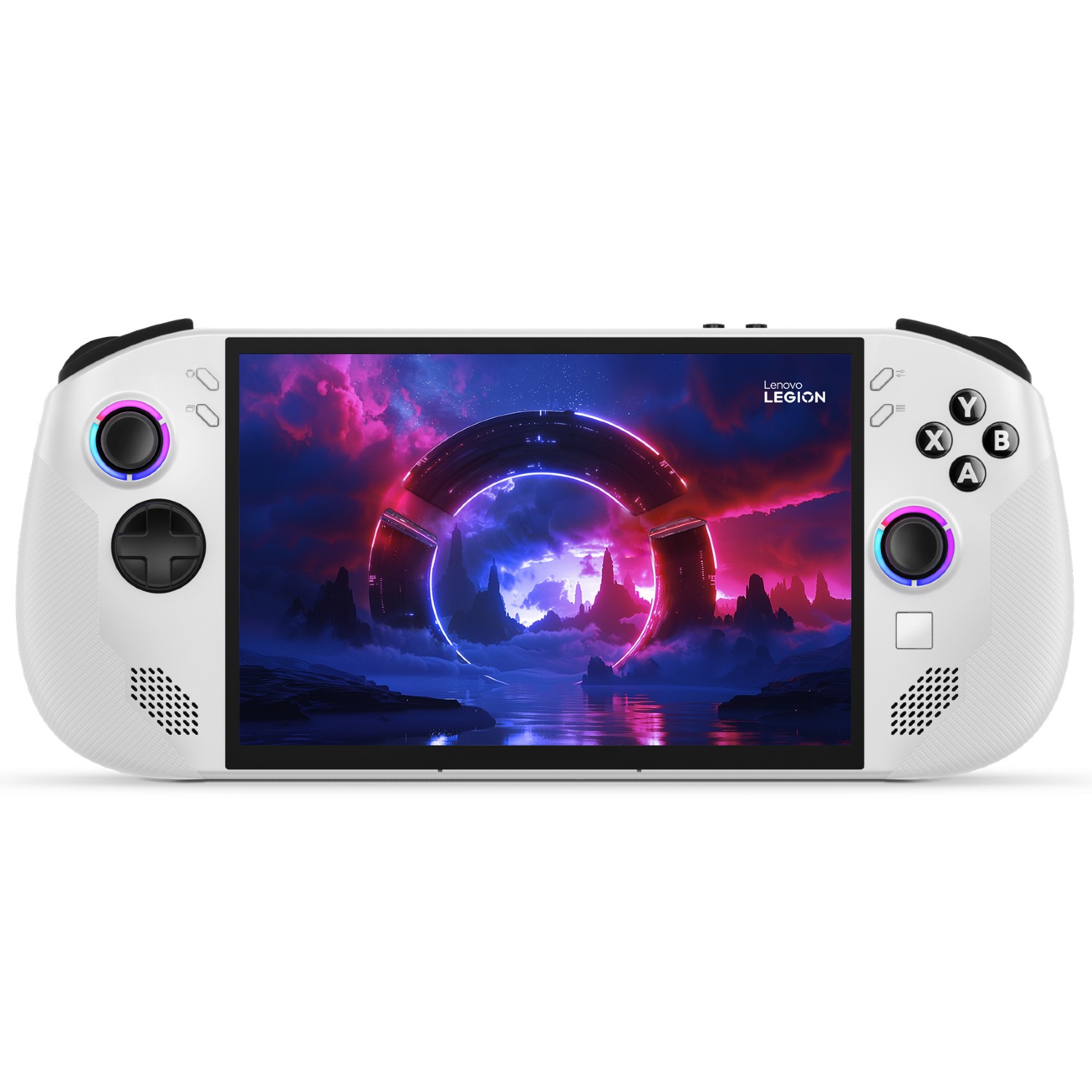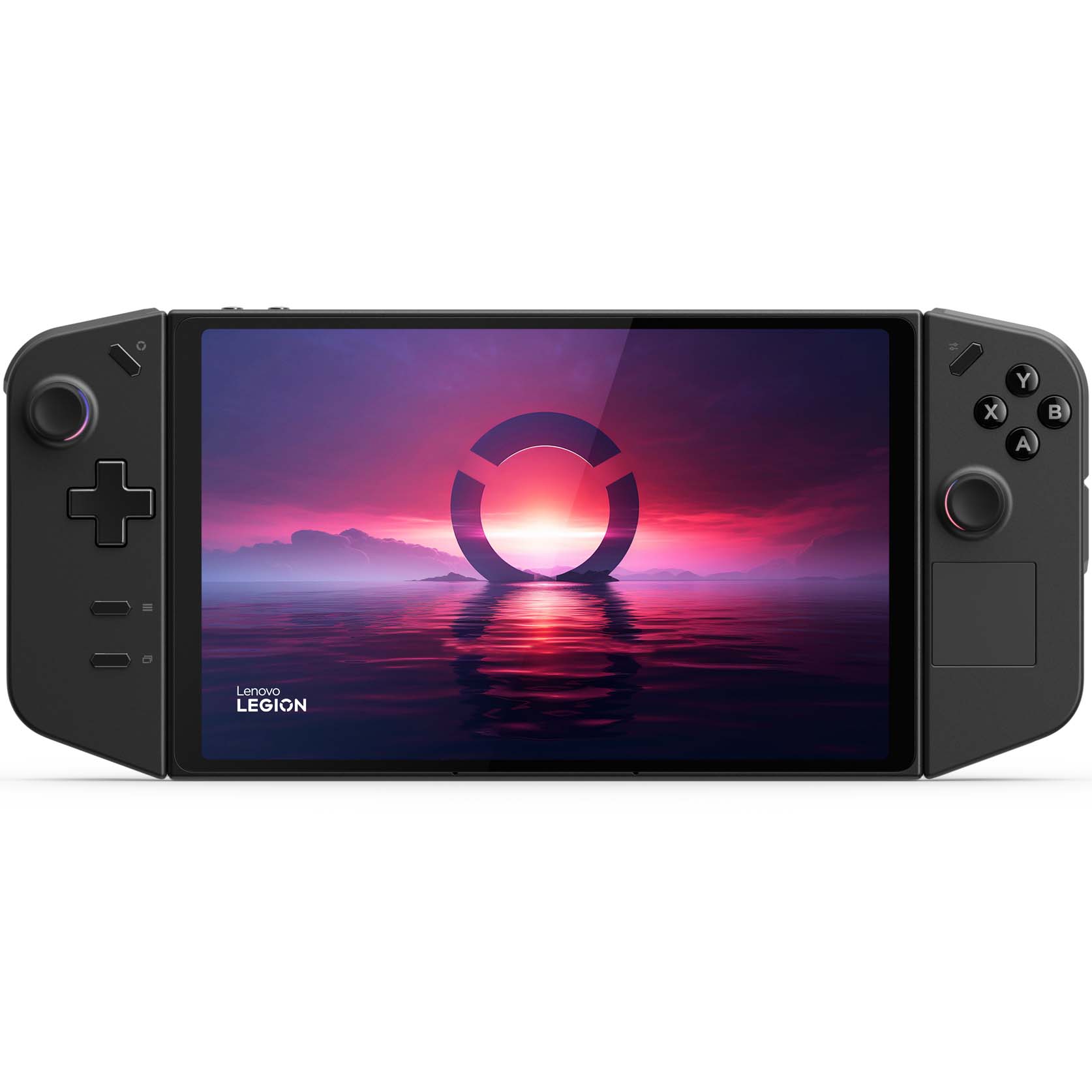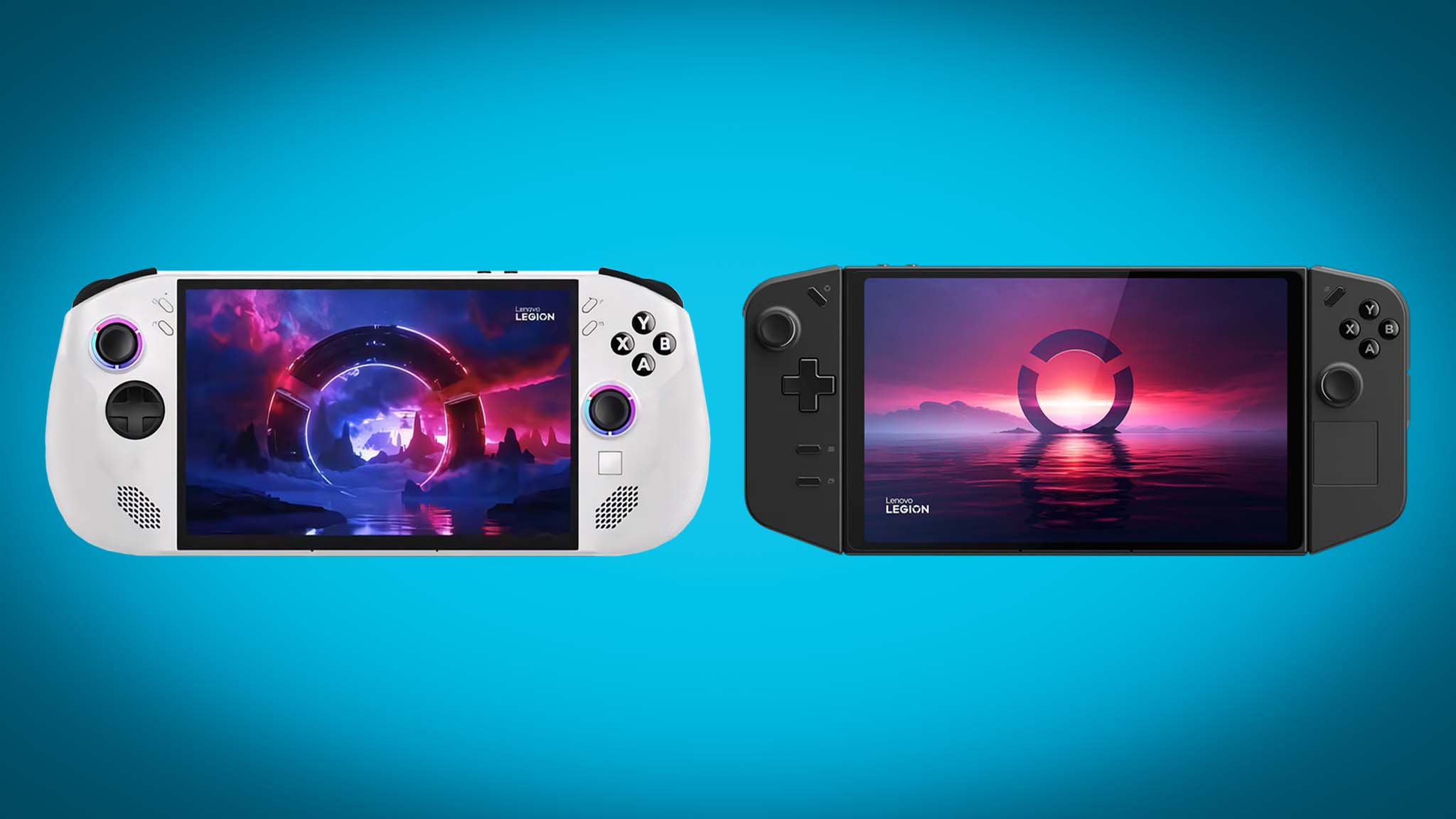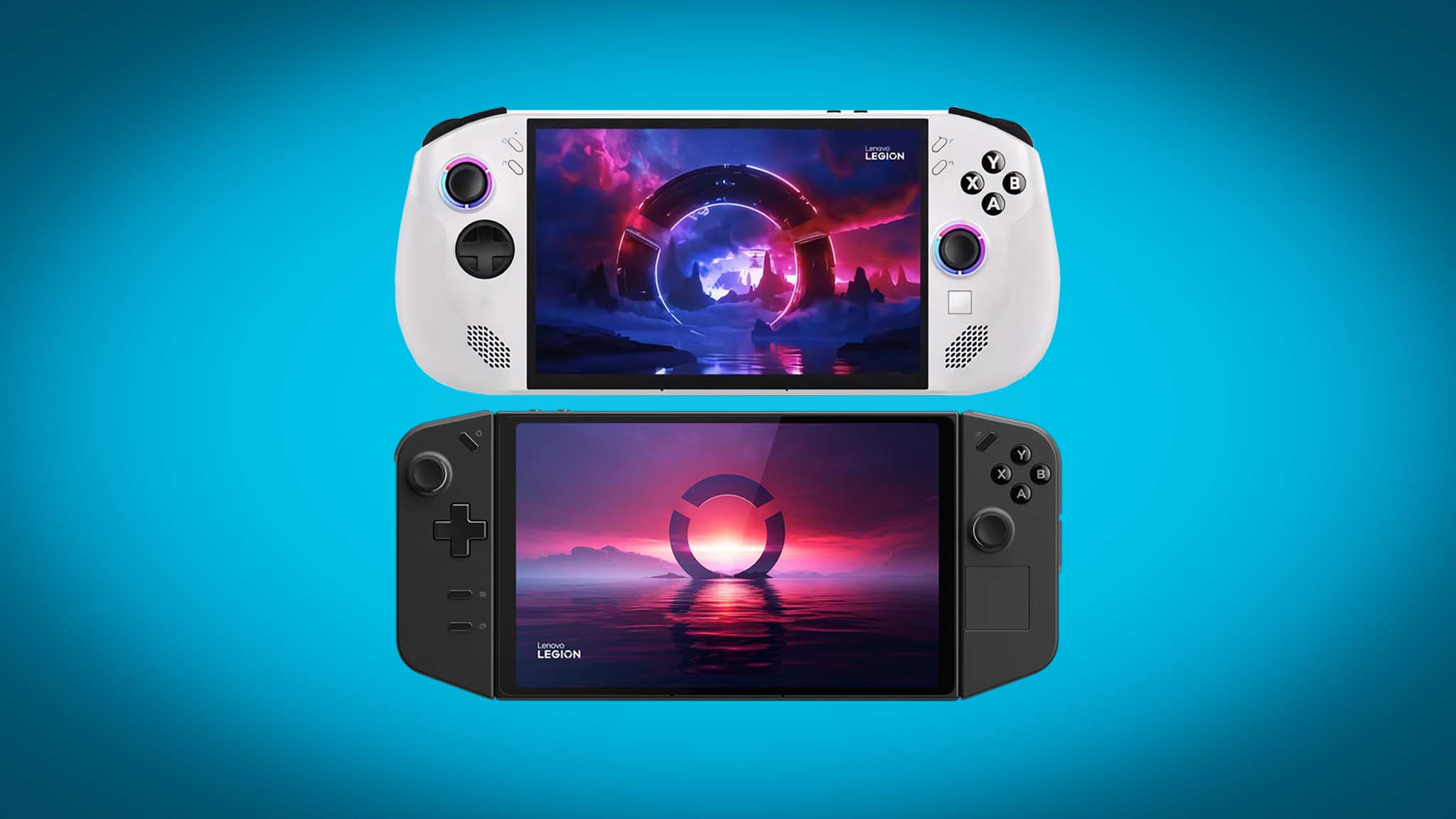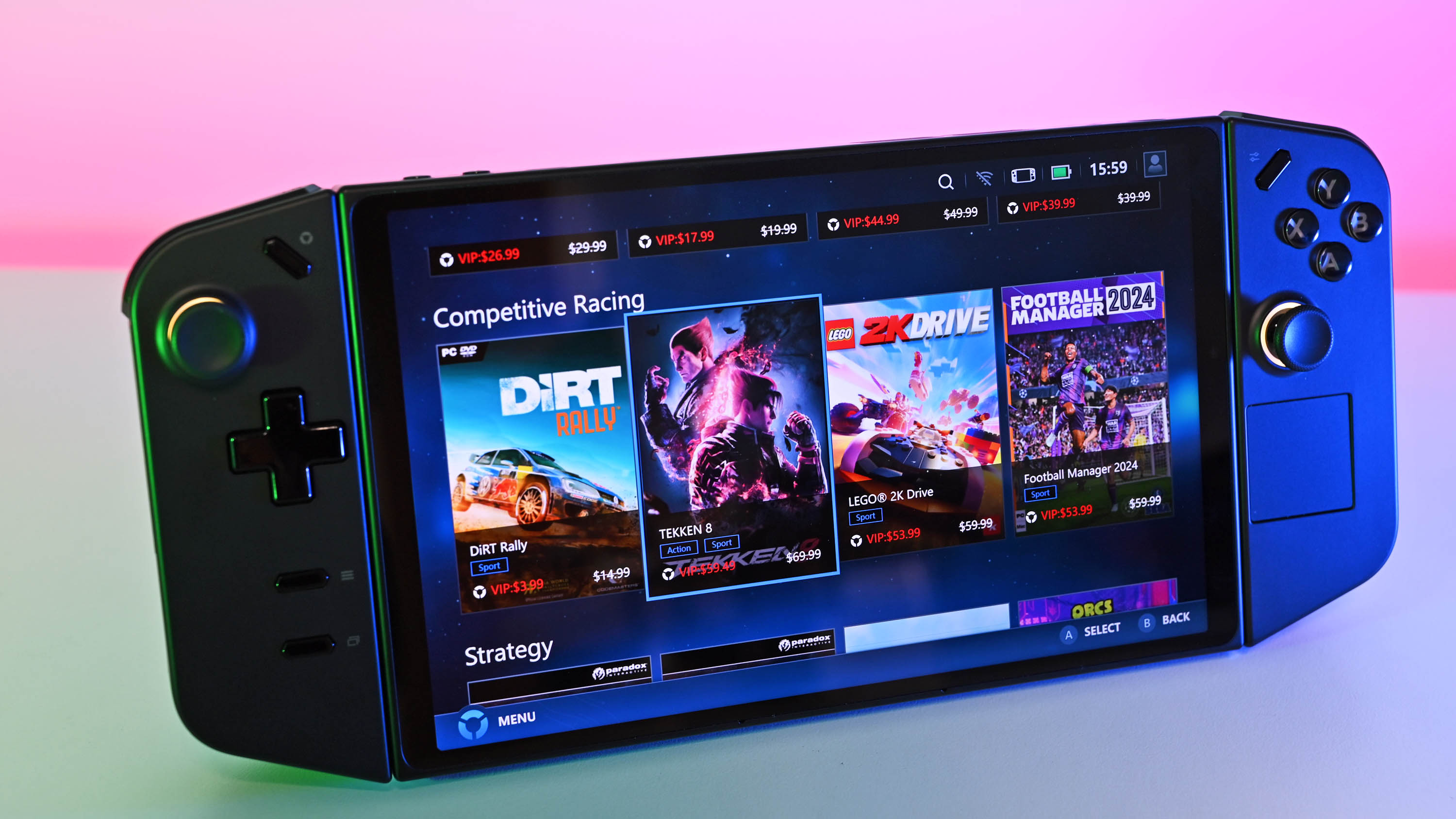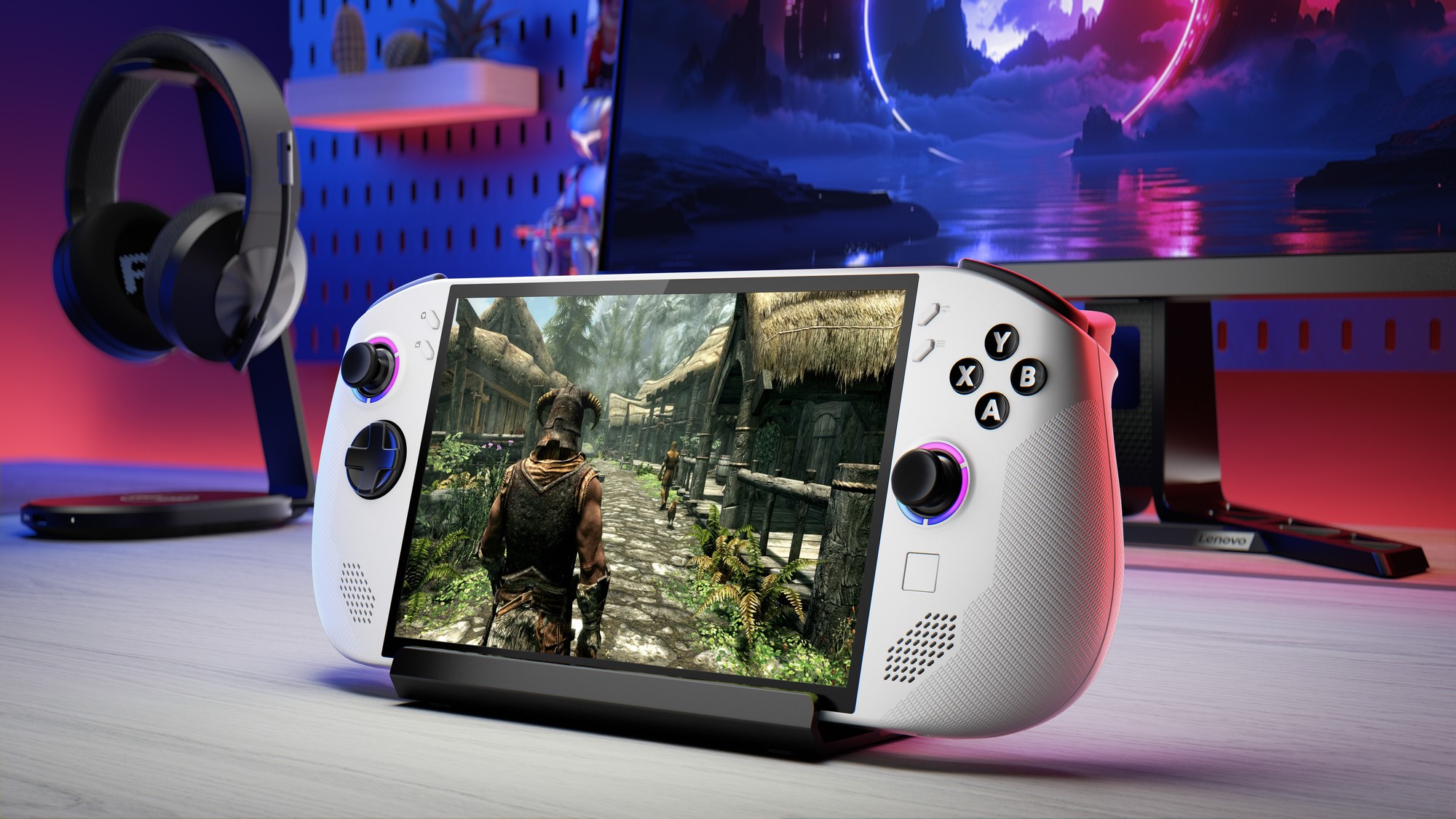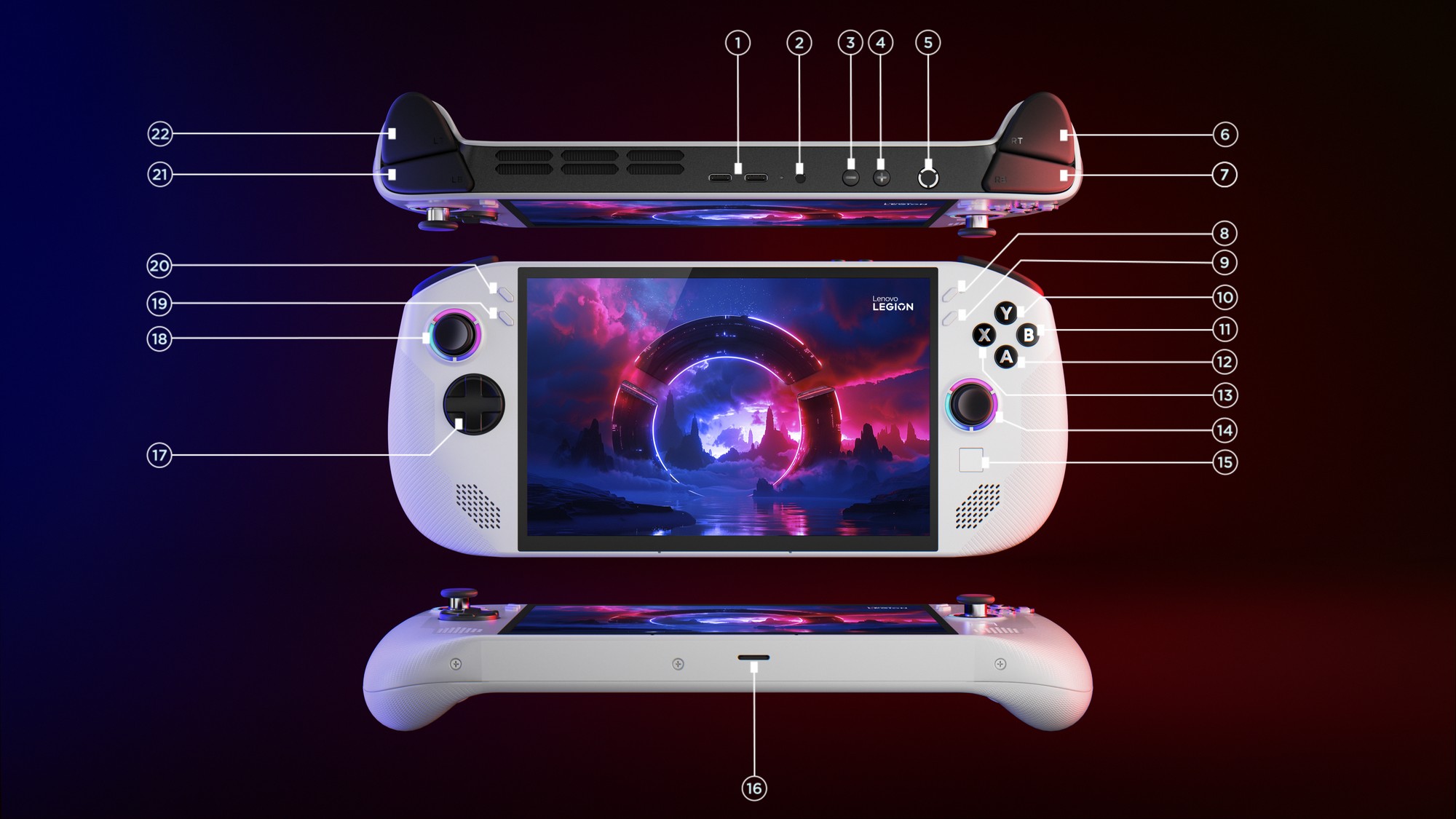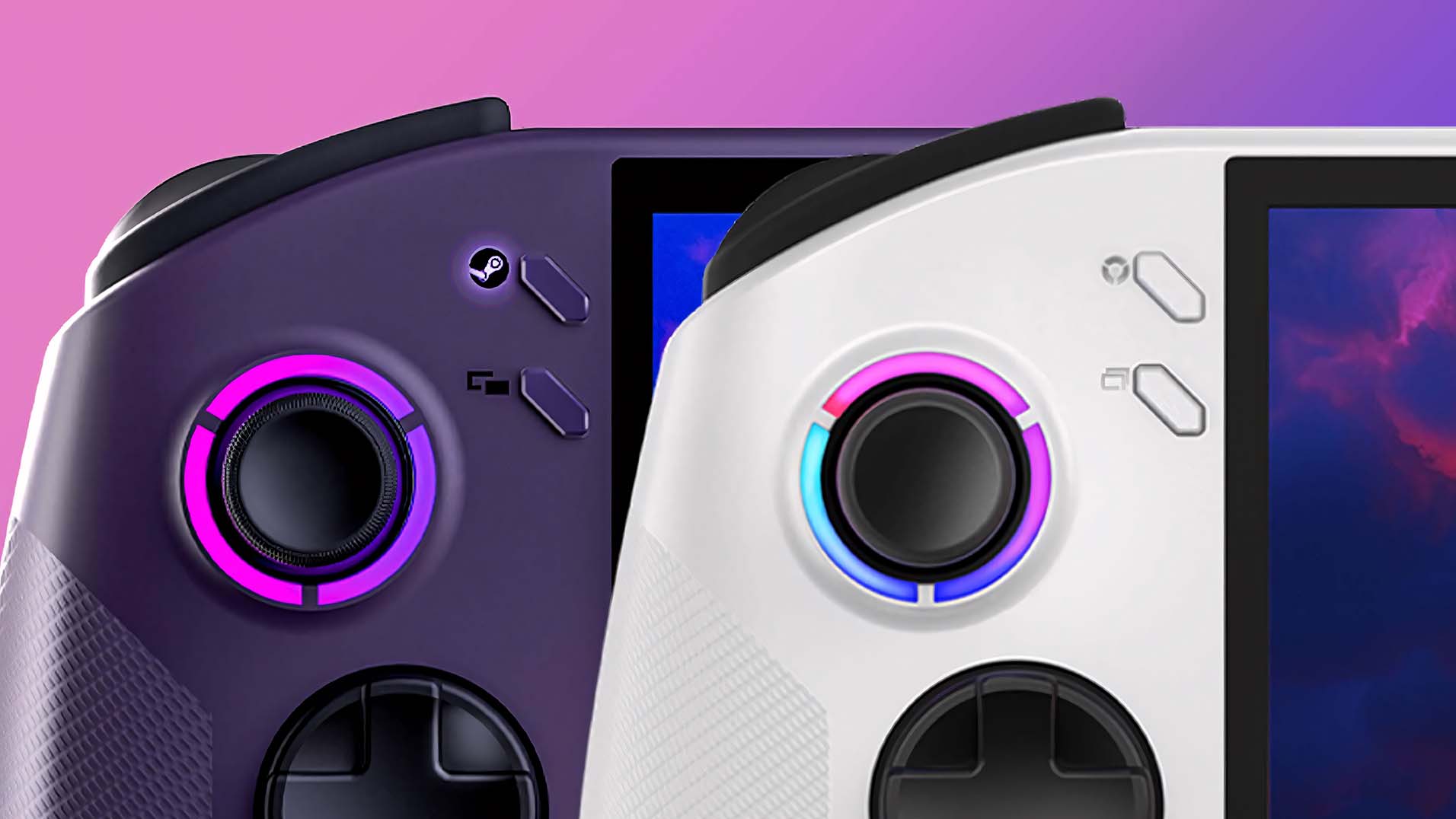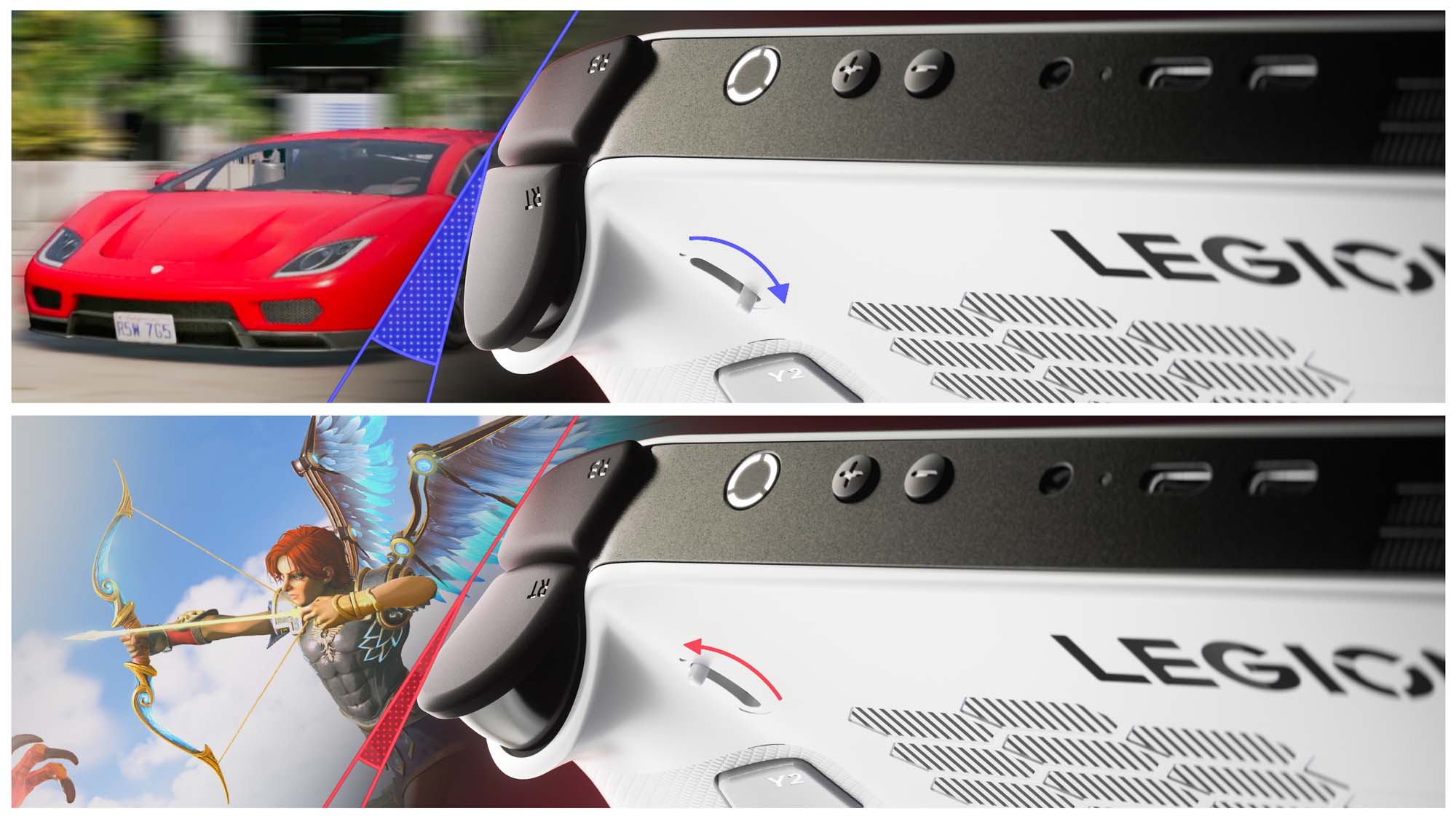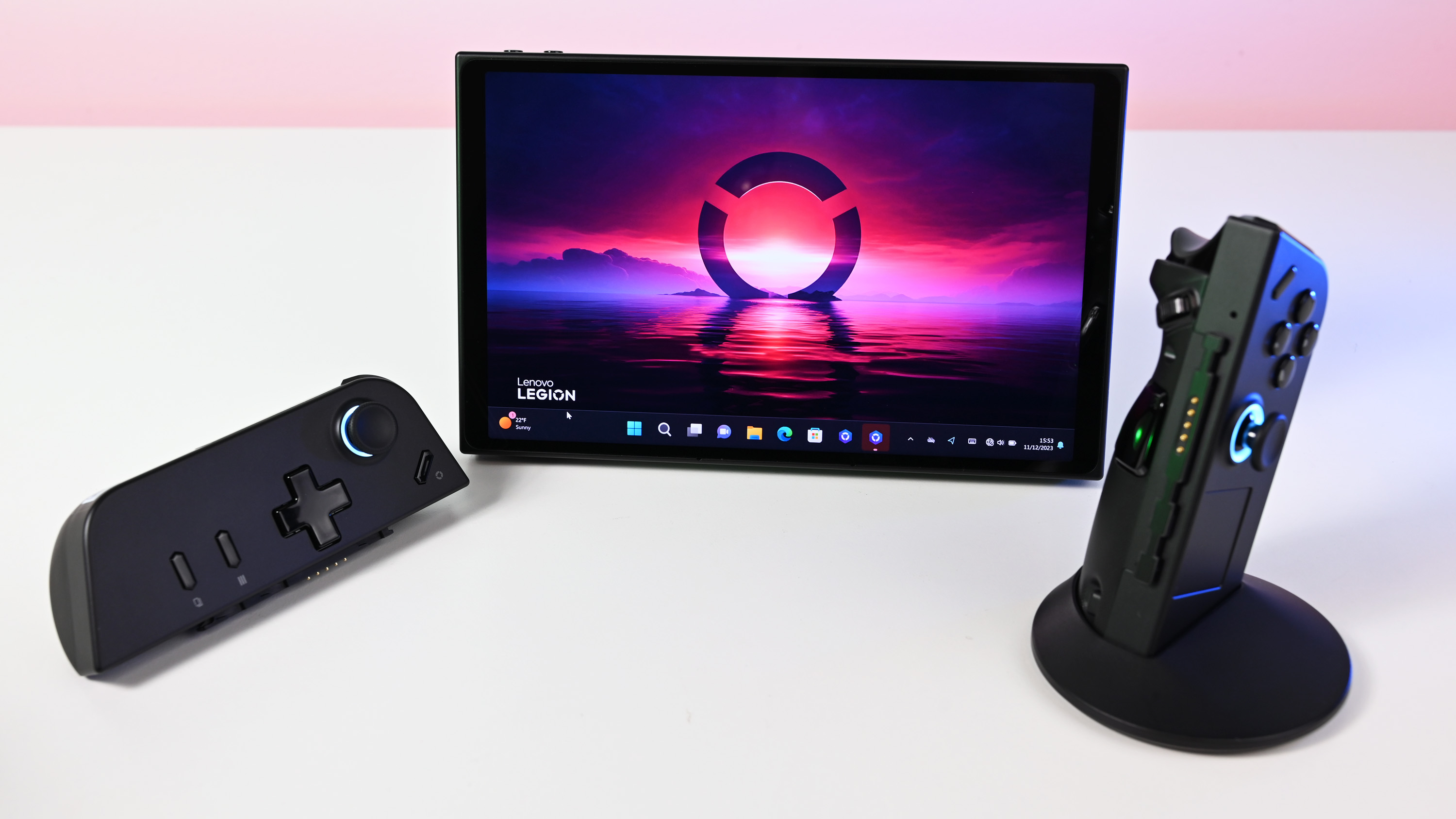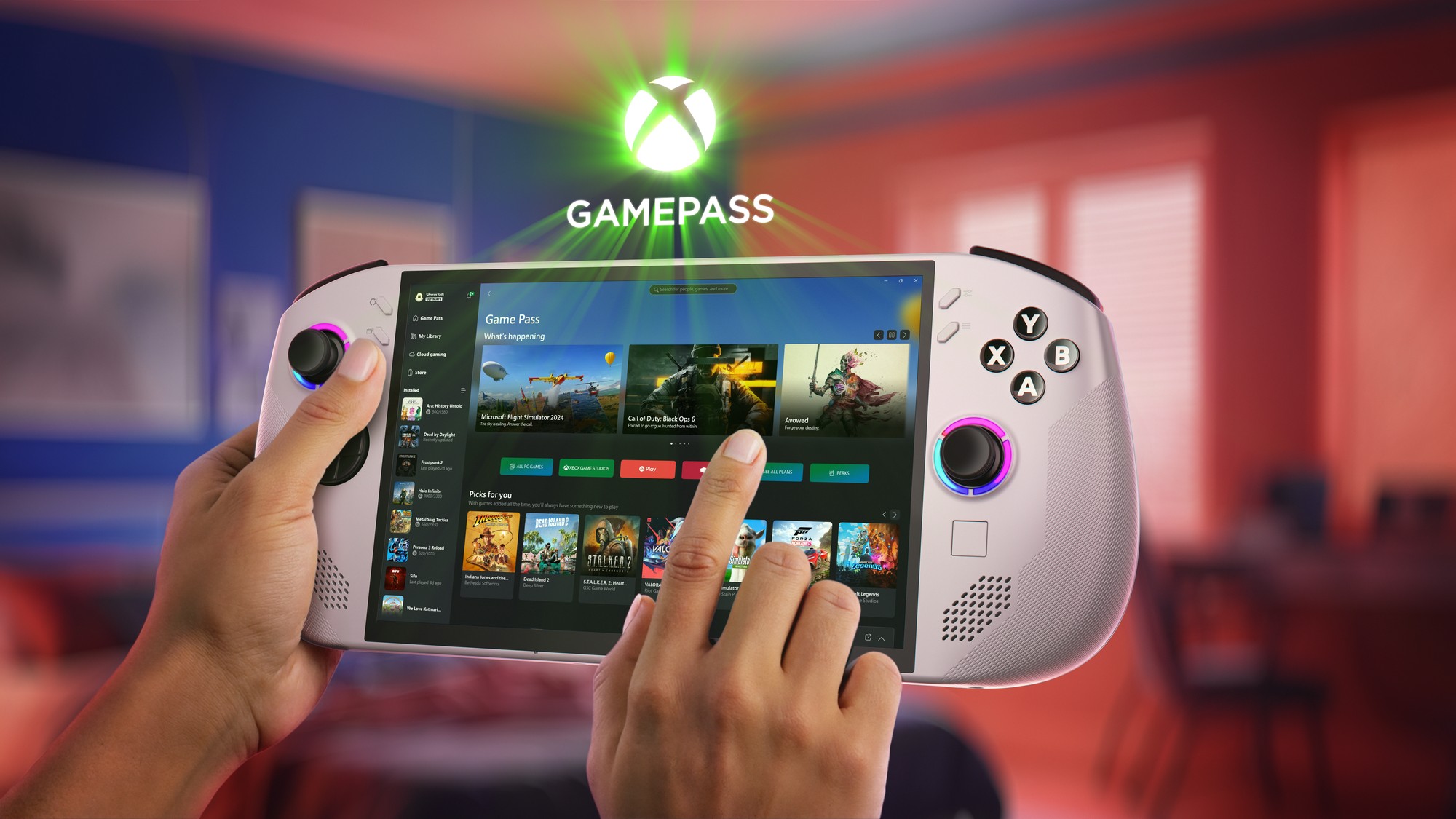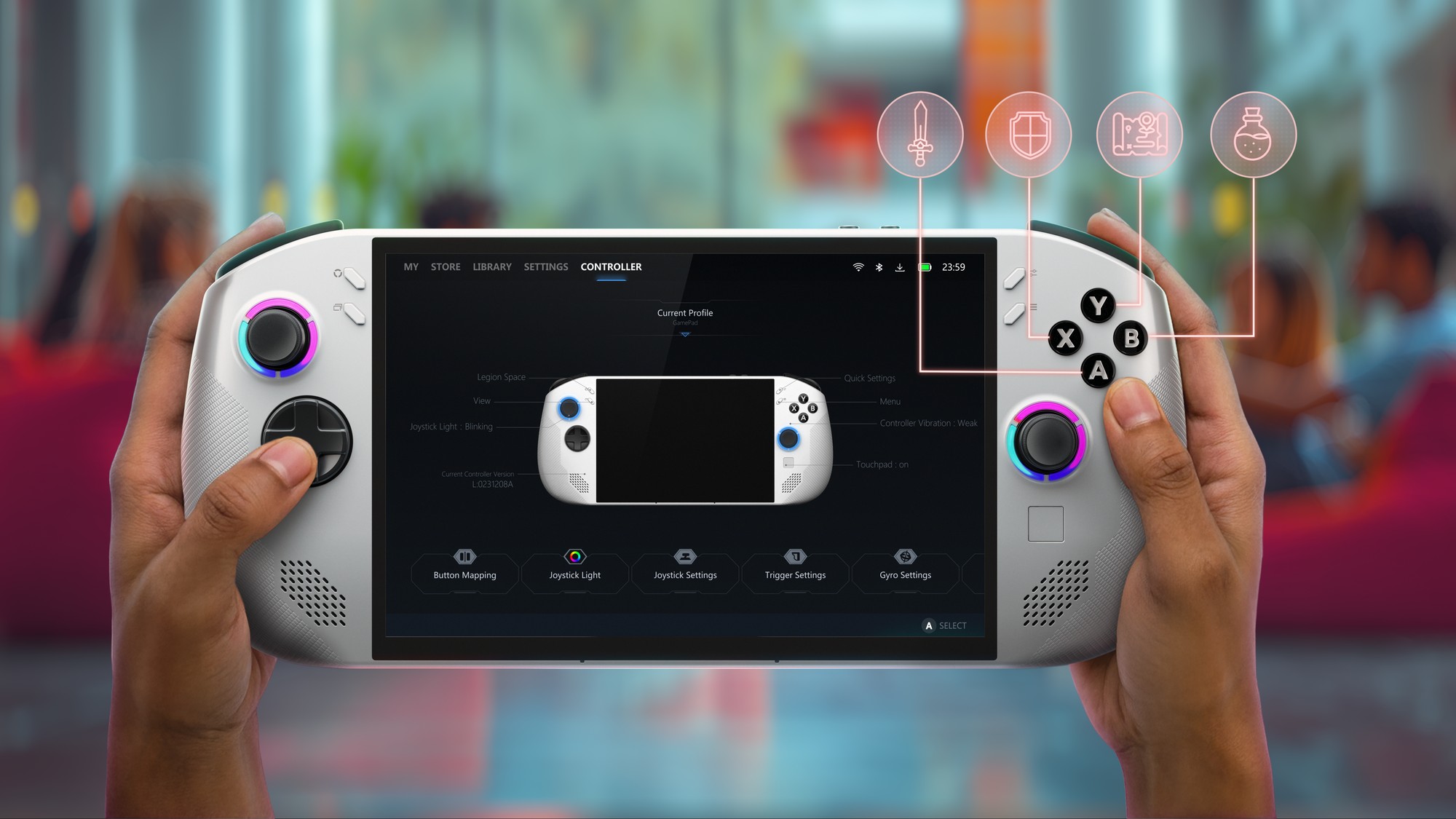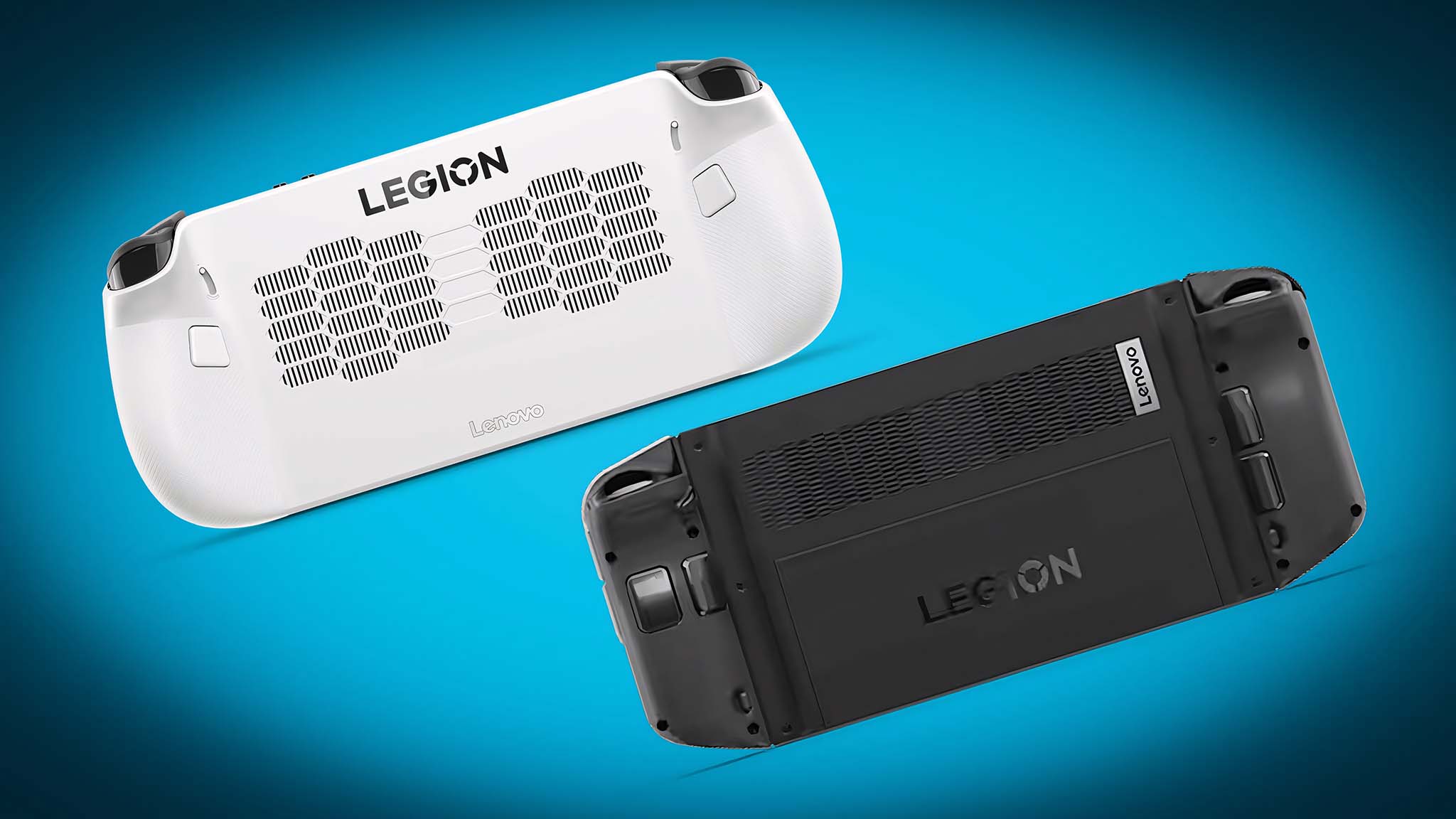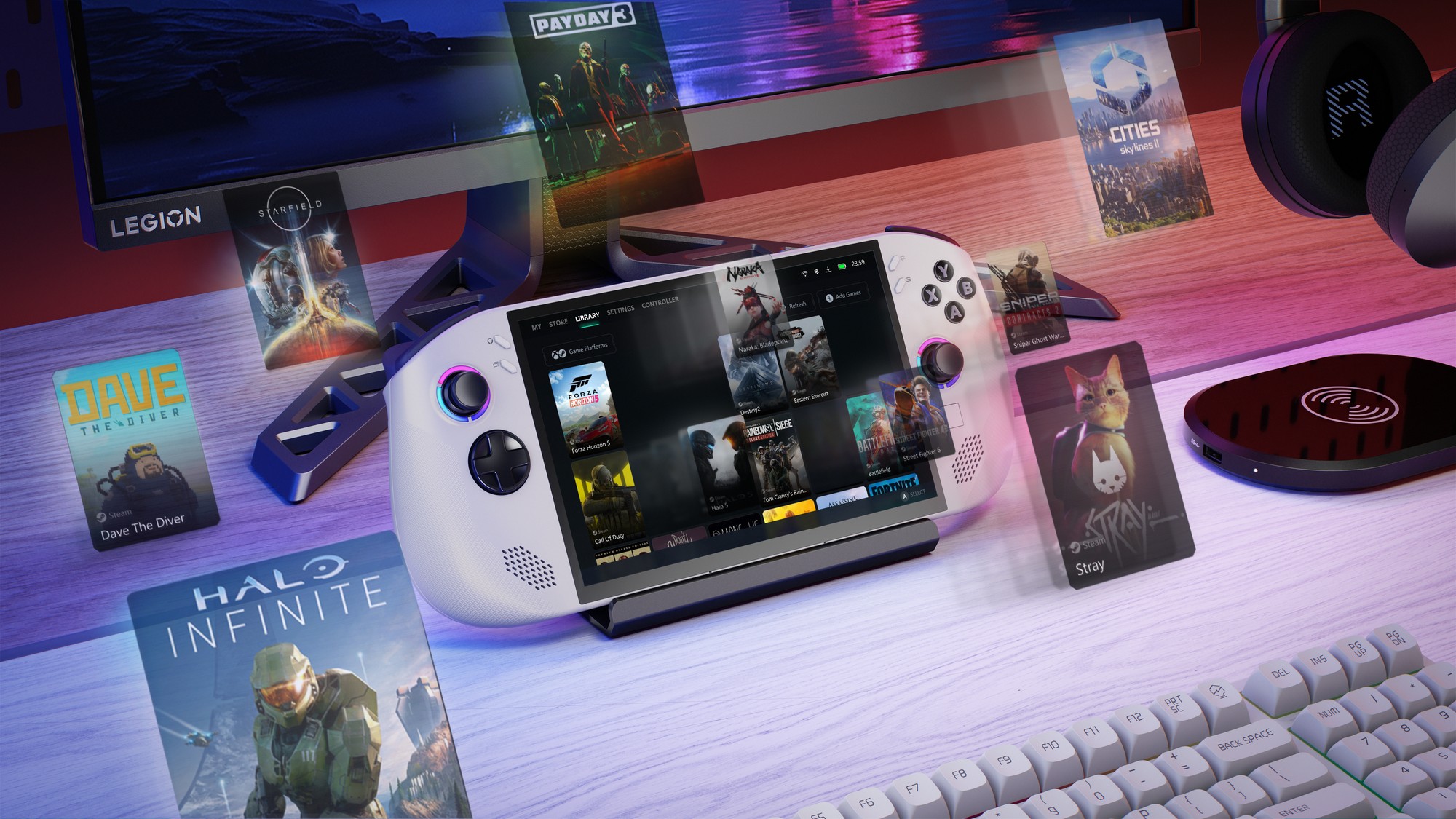This newer Legion Go S is slightly smaller than the original handheld with an 8-inch LCD touchscreen. It’s available in two models, one that runs Windows 11 and another that runs SteamOS. The handheld can have either an AMD Ryzen Z2 Go chip or a Z1 Extreme. The resolution has been lowered to a max of 1920 x 1200p, and the refresh rate is also reduced to 120Hz, but that’s still plenty good for handheld play. It can have up to 32GB RAM and up to 1TB SSD. Instead of simple USB-C ports, this handheld features two Thunderbolt 4 ports to handle your connection needs. Some configurations will be available in January, while others will be available in May.
The original Legion Go features detachable controllers and a built-in kickstand for tabletop play. The 8.8-inch IPS touchscreen supports up to 2560 x 1600 resolution and a higher 144Hz refresh rate but without VRR support. It runs Windows 11 with an AMD Ryzen Z1 Extreme chip, RDNA graphics, 16GB RAM, and up to 1TB SSD. There is no SteamOS version. Additionally, there are two USB-C ports to facilitate simultaneous charging and accessory usage.
For
- Has detachable controllers and a kickstand
- Higher refresh rate and resolution
- Larger 8.8-inch IPS touchscreen
Against
- No SteamOS options
- Doesn’t have Thunderbolt ports
I personally conducted our own Lenovo Legion Go review here at Windows Central shortly after the handheld was released in 2023. It is a fantastic device, but as with most first iterations, it has room to improve. Now, Lenovo has revealed a newer and slightly smaller model in the form of the Legion Go S. While not a next-gen device like the Legion Go 2; it has some improvements over the original handheld as well as some potential downgrades.
It’s also important to note that there are two versions of the Legion Go S. One is officially labeled the Legion Go S (8″ , 1) and runs Windows 11 while the second one is referred to as Legion Go S — Powered by SteamOS (8″ , 1) and runs SteamOS. That’s quite a mouthful, so I’ll mostly just refer to these handhelds as either the Windows 11 or SteamOS version of the Legion Go S.
Legion Go S vs Legion Go: Specs
Let’s dive in and discuss the differences between the original Legion Go and the new Legion Go S devices. Just note that the specs for the SteamOS version of the Legion Go S haven’t fully been revealed yet.
| Header Cell – Column 0 | Legion Go S | Legion Go |
|---|---|---|
| Price | $499.99* (SteamOS) | $599.99, $729.99 (Windows 11) | $699 | $749 |
| Release date | Jan 2025 | May 2025 (SteamOS & more configurations) | Nov 1, 2023 |
| OS | Windows 11 Home | SteamOS | Windows 11 Home |
| Display | 8-inch WQXGA (1920 x 1200) 16:10 LCD touchscreen, 500 nits, 97% DCI-P3 | 8.8-inch QHD (2560 x 1600) 16:10 IPS touchscreen, 500nits, 97% DCI-P3 |
| Refresh rate / VRR | 120Hz / Yes | 144Hz / No |
| Processor | AMD Ryzen Z2 Go or AMD Ryzen Z1 Extreme | Unknown | AMD Ryzen Z1 Extreme |
| Graphics | Integrated AMD Radeon 700M Series | Unknown | RDNA Graphics |
| Memory | Up to 32GB 6400Mhz LPDDR5X | 16GB 7500Mhz LPDDR5X |
| Storage | Up to 1TB PCIe SSD (Gen 4) | 512GB | 1TB SSD |
| Connectivity | Wi-Fi 6E and Bluetooth 5.3 | Wi-Fi 6E and Bluetooth 5.3 |
| Ports | 2x USB4, 1x microSD card reader, 1x audio jack | 2x USB-C 4.0, 1x microSD card reader, 1x audio jack |
| Touchpad | Yes (one) | Yes (one) |
| Detachable controllers | No | Yes |
| Color | White or Black | Black |
| Dimensions (controllers attached) | 299 x 127.55 x 22.6mm (11.77 x 5.02 x 0.88in) | 299 x 131 x 41mm (11.8 x 5.15 x 1.61in) |
| Weight | 740g (1.63 lbs) | 854g (1.88 lbs) |
| Battery | 55.5 Whr | 49.2 Whr |
*These are starting prices for the Legion Go S models. Prices can go up depending on the configuration.
As shown in the above table, there are some significant differences between the original Legion Go and the Legion Go S. Now that you’ve been able to see the specs, let’s discuss what these differences mean for you as a potential handheld owner. I’ll go through various comparison categories and explain which handheld is better, but first, take a look at the specs.
Legion Go S vs Legion Go: Price & value
The original Legion Go has a starting price of $699.99, but if you go with the higher SSD, it has a $749.99 MSRP. Meanwhile, things get a bit tricky with the new Legion Go S.
If I understand Lenovo’s press release correctly, then the SteamOS version of the Legion Go S will be the most affordable option, slated with a starting price of just $499.99. However, this particular configuration won’t be released until May 2025, and we don’t fully know its specs yet.
Meanwhile, the only Legion Go S configuration releasing in January only runs Windows 11 and has an AMD Z2 Go CPU, 32GB RAM, and 1TB SSD, and it has a whopping $729.99 MSRP. Apparently, there will also be another configuration that can be either SteamOS or Windows 11, but it will have an AMD Z2 Go, 16GB RAM, 1TB SSD, and $599.99 pricing.
In some ways, you could argue that the original Legion Go is a better value since it does have those extra tabletop mode features, with detachable controllers and a built-in kickstand. But the Legion Go S will have more power and should run games more smoothly (more on that later).
This is a way in which the new Legion Go S differs. There is no built-in kickstand, regardless of if you have the Windows 11 or SteamOS models, and the controllers cannot be removed. Of course, there will likely be a case on the market that can put a kickstand on these newer devices, and you can always pair an Xbox controller with the handheld if you want.
TL;DR: PRICE WINNER: The SteamOS version of the Legion Go S has a much lower starting point of $499.99, but it won’t be released until March 2025. Until then, the original Legion Go actually has a lower starting price than the Legion Go S Windows 11 version that launches in January.
Legion Go S vs Legion Go: Performance
The original Legion Go totes an AMD Ryzen Z1 Extreme processor that has proven to be a fantastic handheld APU. However, the new Legion Go S (Windows 11) has both a Z1 Extreme configuration as well as a configuration with the new Z2 Series chip. AMD has already explained that the newer Z2 processor not only offers far better performance than the Z1 but also improves battery life by quite a bit (more on that later). I assume this extends to the Legion Go S’s AMD Z2 Go chip as well, but I don’t know for sure just yet.
Meanwhile, the specs for the lowest configuration Legion Go S (SteamOS) haven’t been revealed yet. If rumors are true, then its processor won’t be as powerful as the ones offered in the Windows 11 version, though. That would definitely explain the lower price point of this model.
It’s hard to verify this information until we can conduct testing on the Legion Go S ourselves. However, as long as these claims are true, the new Legion Go S (Windows 11) will offer far better performance than the Legion Go.
TL;DR: PERFORMANCE WINNER: Unless something really strange has happened, then the Legion Go S (Windows 11) configuration with a Z2 Go chip will outperform the original Z1 Extreme Legion Go (and that starting Legion Go S (SteamOS)) by quite a bit.
Legion Go S vs Legion Go: Display
The display is somewhat of a tricky topic when comparing the Legion Go and Legion Go S since the winner, in this case, will mostly come down to a matter of preference. Despite the casings being similar in height and length, the Legion Go S has a much smaller screen than the Legion Go.
Simply looking at the specs, you can easily see that the Legion Go’s larger 8.8-inch IPS touchscreen with 2560 x 1600 resolution and 144Hz refresh rate has better specs than the Legion Go S’s smaller 8-inch panel, with its lower 1920 x 1200 resolution and lower 120Hz refresh rate touchscreen. However, the original Legion Go does not support VRR (variable refresh rate), while the new handheld does. In case you don’t know, VRR helps games play more smoothly by eliminating (or significantly reducing) screen tearing and stuttering. To me, that more than makes up for the Legion Go S’s lower refresh rate.
As for screen size, It might not seem like a big difference, but an 8.8-inch panel will feel a lot larger than an 8-inch one when held in your hands. But bigger isn’t always better unless you specifically want a handheld with a large display.
TL;DR: DISPLAY WINNER: This is a tricky one to call since the two devices have some tradeoffs. Legion Go S actually supports VRR, so that gives it an edge over Legion Go even if it has a smaller screen, lower refresh rate, and lower max resolution. Still, if you specifically want a big screen that can be put in tabletop mode, then the Legion Go will suit you better.
Legion Go S vs Legion Go: Controls and play modes
One of the biggest differences between the Legion Go and Legion Go S is that the former has a built-in kickstand and detachable controllers, while the Legion Go S does not.
If you look at the front and back of the Legion Go S compared to the original Legion Go, you’ll notice that some buttons and controls have been rearranged or removed entirely. For example, I personally have a hard time reaching the Menu and View buttons on the bottom left Legion Go controller, but their new placement looks a lot more manageable on Legion Go S.
It’s also worth noting that there is a difference between the Windows 11 Legion Go S versus the SteamOS handheld. On the Windows 11 version, the top left button brings up Legion Space, but the Steam version has a Steam button instead.
Speaking of the front of the device, both the Legion Go S and Legion Go have ABXY buttons, two Hall Effect joysticks, a D-Pad, bumpers, triggers, Menu buttons, View buttons, and Legion R buttons. But you’ll notice that the D-Pad looks different, and the touchpad has been made a whole lot smaller on the Legion Go S. It’s currently unclear how this smaller touchpad affects navigation, but if it’s made well, it shouldn’t be an issue.
As for the back, there are only two buttons on the back of the new Legion Go S compared to four back buttons, two side buttons, and a mouse wheel on the backside of the Legion Go. This reduction in back controls is largely due to the Legion Go S not having detachable controllers and, thus, not needing FPS mode buttons.
However, you will notice that the Legion Go S has something on the back that the Legion Go doesn’t have — adjustable trigger switches, which can help give players better control during different types of games. I’ll have to see how well these work myself before I say whether this is a good or bad addition.
TL;DR: CONTROLS WINNER: Since it has a better layout and gets rid of unnecessary buttons, the new Legion Go S has better controls.
Legion Go S vs Legion Go: Software and games
Software and games is yet another nuanced area for the Legion Go S. The original Legion Go runs Windows 11, but the new Legion Go S has two variants — A Windows 11 version and a SteamOS version.
The Windows 11 Legion Go S version and the original Legion Go (which also runs Windows 11) can access any gaming service or retailer that you would be able to access on a gaming laptop right out of the box. For instance, you’ll be able to use a web browser to access Steam, Epic Games, Battle.net, and more.
However, many people will be drawn to the SteamOS Legion Go S since this Linux-based operating system has a simplified interface, which makes the handheld feel more like a game console than a full-blown computer. Just like with the Steam Deck, SteamOS literally ties to your Steam account, making it quick and easy to access your Steam library of games without having to navigate around the internet. However, adding other services requires getting to the desktop mode and adding other features, which might be confusing for people who aren’t familiar with Linux.
That said, anyone who is familiar with Linux can tell you that it is highly customizable. If you’re more comfortable with Windows 11 and want to do more than just play games on your handheld, then a Windows 11 operating system might be a better fit.
TL;DR: SOFTWARE & GAMES WINNER: The Legion Go S wins this category since it offers more options to choose from, whether you want to access any gaming service out of the box with the Windows 11 version or else want a simplified but highly customizable SteamOS interface.
Legion Go S vs Legion Go: Battery life
The Legion Go S is undoubtedly going to have better battery life than the original Legion Go handheld. For one thing, the original handheld has a smaller 49.2 Whr battery than the Legion Go S’s 55.5 Whr battery. On top of that, the new AMD Z2 Extreme chip aims to increase battery life by 300% in gaming handhelds. So, the Legion Go S configuration with the new Z2 Go chip should last longer than the Z1 Extreme configuration.
Specifically, AMD’s senior vice president, Jack Huynh, reportedly suggested that the AMD Z2 chip would boost the battery life of high-end performance mode from 45 minutes to 3 hours.
It’s also possible that having Windows 11 vs SteamOS could impact the device’s battery life. But we’ll have to wait until we test these devices ourselves to know for sure.
TL;DR: BATTERY LIFE WINNER: The Legion Go S has much better battery performance since it has a larger battery capacity and a new chip that boosts battery life.
Legion Go S vs Legion Go: Grip ergonomics and comfort
I have pretty average-sized hands, but when I first held the Legion Go, I immediately noticed that the boxy device and controllers were uncomfortably thick. Even my 6-foot-five husband, with his larger-than-average hands, found the handheld a bit too large to hold comfortably.
The original Legion Go measures 11.8 inches wide, 5.15 inches tall, 1.61 inches thick, and it weighs a hefty 1.88 pounds. Meanwhile, the new Legion Go S (Windows 11) is roughly the same height and width but notably lighter and thinner. Not to mention, it isn’t nearly as boxy as its predecessor, which should be easier on the hands. It measures 11.77 inches wide, 5.02 inches tall, 0.88 inches thick, and weighs 1.63 pounds.
As such, it’s easy to assume that the new Legion Go S (Windows 11), with its refined and slimmed-down shape, is easier to grasp. As long as Lenovo did a good job of balancing the weight of the internals, it might put a bit less strain on wrists as well. It’s possible that the SteamOS version of the Legion Go S could have a different weight than the Windows 11 one, but we don’t know for sure at this moment.
On another note, I personally find it hard to get my thumb to reach the lower two buttons on the original Legion Go’s left controller. However, these buttons have found new placement on the Legion Go S, which should make them easier to access and, thus, more comfortable to use.
TL;DR: COMFORT WINNER: Based on the slimmer casing, reduced weight, and more rounded design, the Legion Go S more than likely is easier to hold.
Legion Go S vs Legion Go: Accessories
The Legion Go comes with a hard shell carrying case and an FPS mode stand for the detachable right controller. Additionally, there are a few third-party docking stations, protective cases, skins, and other accessories on the market. While not an accessory, the fact that it has a built-in kickstand with that larger screen means that it’s very easy to pair a keyboard to the Windows 11 handheld and use it like a computer; you don’t have to go by a peripheral with a kickstand if that’s a feature you want.
As for the Legion Go S, there might be some pairing differences between the SteamOS version and the Windows 11 version. Additionally, it’s new to the market, so there aren’t as many accessories specifically made for its shape and size just yet. However, if the handheld does well, more third-party options will likely become available over time.
TL;DR: ACCESSORIES WINNER: This win goes to the Legion Go. Simply by virtue of having been out on the market longer, there are more third-party accessories available for the older device. However, that could change with time.
Legion Go S vs Legion Go: Comparison chart
| Category | Winner |
|---|---|
| Price | Legion Go S (SteamOS) — Starting at $499.99, this upcoming handheld is cheaper than the $699.99 starting price of the Legion Go or the $729.99 starting price of the Legion Go S (Windows 11). |
| Performance | Legion Go S (Windows 11) — We’ll have to wait until proper testing can be done, but the new AMD Z2 chip in the Legion Go S should be significantly more powerful than the previous Z1 Extreme. We don’t know the processor for the SteamOS Legion Go S yet. |
| Display | Legion Go — Technically, the original handheld is larger, has higher resolution, and a higher refresh rate. |
| Controls & ports | Legion Go S — The newer buttons and controls have been improved upon, plus they’ve been rearranged, which makes them easier to access. Additionally, the new handheld has Thunderbolt 4 ports, which is an improvement over the USB-C ports. However, if you specifically want something you can play in tabletop mode with detached controllers than the Legion Go is a better pick. |
| Software & games | Legion Go S — This one will come down to a matter of preference. The Windows 11 Legion Go S can access the same services as the original Legion Go out of the box. However, the some people will find the SteamOS configuration easier to use due to its simplified interface. Legion Go S wins in this case because it offers more options than Legion Go. |
| Battery life | Legion Go S — The newer handheld has a larger battery capacity and includes a processor that is designed to offer better battery life. |
| Grip | Legion Go S — Due to its slimmer design, lighter weight, and rearrangement of buttons, the newer Legion Go S is likely more comfortable to hold. |
| Accessories | Legion Go — This win goes to the original handheld simply because it has been out longer on the market and so there are more accessories for it at the moment, but this could change. |
| Best overall | Legion Go S — With more configuration options to choose from and various improvements the newer handheld offers a better user experience. |
Legion Go S vs Legion Go: Which should I buy?
Alright, we’ve discussed all of the differences between the Legion Go and the Legion Go S variants, but which one should you actually buy? Honestly, they are all great gaming handhelds to go with, but they each serve different needs, so it partially depends on what you specifically want from your handheld.
Our Top Gaming Recommendations
The new Legion Go S has a lot of improvements over the original device that should help it play games more smoothly and last a lot longer during play sessions. Plus, you can opt for the SteamOS version if you don’t want to deal with the hassle that Windows 11 navigation and troubleshooting can cause.
However, the original Legion Go might still be a better choice for some people. It has that larger screen, higher resolution, higher refresh rate, detachable controllers, and a built-in kickstand. As such, it serves as a great computer for anyone who pairs a keyboard with it. Plus, you can detach the controllers and use it more like a tablet to stream shows if you want.
Consider what features you want most in your handheld, and if you just want a simple gaming device, then go for the Legion Go S. If you want more of an all-rounded gaming and entertainment device, consider the Legion Go.
This new device is ideal for people who simply want a handheld gaming system. Depending on the configuration you go with, it can run SteamOS or Windows 11. It can have up to a Z2 Series chip, up to 32GB RAM, and up to 1TB SSD to meet your gaming needs.
The original Legion Go is a fantastic choice for people who want a handheld with a larger screen or for people that want to use their device in tabletop mode. This 8.8-inch screen device comes in two configurations with a Z1 Extreme processor, 16GB RAM, and up to 1TB SSD.


